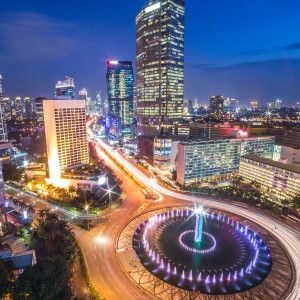American Indonesian Chamber of Commerce

- HOME
- ABOUT AICC
- The History of AICC
- Major Initiatives
- Trade, Tourism, and Investment Program (TTI)
- Opportunity Indonesia
- Introducing Indonesia: Scholastic Ambassador Program
- Preventing A Lost Generation
- Comprehensive Indonesian-English Dictionary
- Sustain Sumatra
- 10 Year’s After: A nationwide public awareness program
- Support to Mandiri Craft
- Congressional Staff Visit
- Business and Cultural Programs in Dallas, Texas
- US-Indonesia Women’s CEO Summit
- Topeng Sehat: AICC Initiative Against COVID-19
- 2021 Shipping NYC Surplus PPE To Indonesia
- Board of Directors
- Membership Benefits
- FAQ
- Membership Registration and Forms
- EVENTS
- LINKS
- TRADE LEADS
- LATEST NEWS/COMMENTARY
- DOING BUSINESSS
- COUNTRY DATA
- BLOG POSTS





AMERICAN INDONESIAN CHAMBER OF COMMERCE





Issue To Watch: Two Nations Adopting Industrial PoliciesCommentary by Wayne Forrest Indonesia and the US are two nations that share many characteristics: large agricultural exporters, similar mottoes (Bhinneka Tunggal Ika, Unity in Diversity, E Pluribus Unum, Out of Many One), diversity of ethnic groups and languages; big producers of oil, gas, and minerals; colonial pasts, multiple time zones, huge appetites for social media. I could go on. They now share something else: an affection for industrial policy. This concerns me as the ability of governments to pick winners and losers has a very mixed track record and policies are usually devised based on false premises. Two developments affected the policies of both countries: the COVID pandemic and China’s militaristic challenge to Taiwan. Both nations have created policies favoring particular industrial sectors and the replacement of imports. In the US it’s the Inflation Reduction Act (IRA) and CHIPS Act. In Indonesia it’s a set of policies to keep earnings from foreign exchange onshore and limiting or banning the export of raw materials (wood, metals) to force local processing and value-added downstream manufacturing. Both pieces of US legislation headline on-shoring of semiconductor manufacturing and electric vehicle and battery production via subsidies and non-tariff barriers. Starting with an export ban of nickel, Indonesia policies are a means to force the down-streaming of all its raw mineral products into primarily the electric vehicle industry. Although its not an immediate concern as Indonesia has a sizable local market, the tough environmental clauses of the IRA could make it difficult for Indonesia to export batteries to the US. Both countries are offering big subsidies for consumer purchases of EV’s. It is very understandable that politicians in both countries would pursue policies to protect industries that are job creators. What is not discussed is how long an industrial policy will last and what a government will do if they fail. A basic question: what if the locally produced product, its import banned by either a very high tariff or the ban of an export used as a component, is more expensive? Could not those resources be better used and isn’t it too complicated for the government to attempt to figure it all out? US and Indonesian policymakers may be looking to postwar Japan as a good example for industrial policy. Japan’s industrial policy seemingly helped but not as much as is commonly understood. Japan’s great post war advances in automobiles and consumer electronics had more to do with very high savings rates and good corporate labor and management policies than tariff and non tariff barriers. MITI protections in oil, agriculture (rice), and steel have hampered Japan for years and its support for local telecommunications standards hived off manufacturers from the worldwide market for cellular phones when these were invented. Once a policy is in, even ones that go bad, are hard to get rid of. Indonesia’s industrial policy has already brought it big gains in stainless steel production along with protests over its nickel export ban from the EU that resulted in a loss at the WTO. (US policy is newer and cannot yet be measured.) Undeterred, Indonesia plans similar bans for tin, copper, bauxite, and possibly rubber. These may lead to short term gains but also generate other distortions that could bring negative unintended consequences. For example, what if EV batteries are invented that don’t use a relatively expensive metal such as nickel? What if most of the financing for downstreaming comes from offshore, as it currently does, placing downward pressure on Indonesia’s currency? Is the Indonesian worker productive enough in sufficient numbers for the hundreds of factories anticipated by government planners. Its not difficult to imagine scenarios where basic mining products wait for buyers. For the US the Biden Administration’s focus on bringing home manufacturing jobs from overseas is misleading and is based on a fallacy that we have de-industrialized. That’s not the case. Although manufacturing employment has dropped significantly since the 1940’s the more important ratio of manufacturing to GDP at least in the US has consistently averaged 12% for the past 70 years. What this means is that US industrial output has changed little; we are producing more goods with fewer workers. Most economists who have studied industrial policy have concluded that building a more resilient economy free from distortionary fiscal and monetary policies is better in the long run. Let great entrepreneurs figure out the industrial processes and business models that yield high quality, affordable products, rather than government planners. “To work, the benefits and the costs of any policy must be identified and measured correctly. Each subsidy given to an industry or firm generates an opportunity cost: the cost of foregone alternatives. In other words, to correctly evaluate a policy, you need to know not only what you’re getting, but also what you’re giving up. Based on industrial policy experiments in several countries, most economists have little confidence in the government’s ability to measure these benefits and costs properly.” (1993 St. Louis Fed paper) (These views are the author’s and may not reflect those of AICC or its members.) |